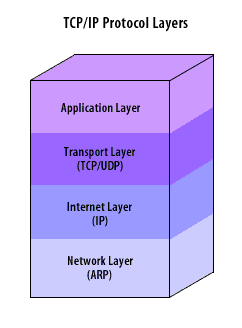Interoperability in the TCP/IP Protocol Stack
Interoperability in the TCP/IP protocol stack refers to the capacity of protocols at each layer to seamlessly interact and cooperate with each other. Each layer provides services to the layer above it and relies on services from the layer below it. Here's an exploration of the interoperability between the Application, Transport, Internet, and Network Interface layers, focusing on TCP/UDP, IP, and ARP protocols.
Interoperability in the TCP/IP model is a result of each layer's design to provide services to the layer above and receive services from the layer below. This design ensures that each layer can focus on its specific tasks, while still working together to facilitate the end-to-end transmission of data over a network. Each layer interacts with the layers adjacent to it, with protocols like TCP/UDP, IP, and ARP playing key roles in these interactions. This layered interoperability is fundamental to the operation of networks based on the TCP/IP model.
- Application Layer and Transport Layer (TCP/UDP): The Application Layer interacts directly with the Transport Layer. Applications typically use TCP or UDP based on their needs. TCP provides reliable, ordered, and error-checked delivery of a stream of data, making it ideal for applications requiring data integrity over speed. On the other hand, UDP is used when speed is preferred over reliability, as it offers a connectionless datagram service that emphasizes reduced latency over reliability.
Applications interface with TCP or UDP using ports, which are unique identifiers that allow the Transport Layer to deliver data to the correct application. - Transport Layer (TCP/UDP) and Internet Layer (IP): The Transport Layer communicates directly with the Internet Layer. Regardless of whether TCP or UDP is used at the transport layer, they both rely on IP to deliver their data units (TCP segments or UDP datagrams) to the correct host on a network.
TCP or UDP pass their data units, along with addressing information (like the source and destination IP addresses), to IP, which encapsulates them into IP packets, also known as datagrams. This interoperability is crucial for end-to-end data delivery over a network. - Internet Layer (IP) and Network Interface Layer (ARP): The Internet Layer depends on protocols at the Network Interface Layer for the delivery of its packets across networks. Address Resolution Protocol (ARP) is a critical protocol at this layer that interacts with IP. ARP's role is to map an IP address (a logical address at the Internet Layer) to a physical address (MAC address), facilitating data transfer on a local network. When IP has an IP datagram destined for a host on the local network, it will query ARP to provide the corresponding MAC address. ARP enables IP packets to be correctly delivered on a local network, bridging the gap between logical IP addresses and physical MAC addresses.
Interoperability in the TCP/IP model is a result of each layer's design to provide services to the layer above and receive services from the layer below. This design ensures that each layer can focus on its specific tasks, while still working together to facilitate the end-to-end transmission of data over a network. Each layer interacts with the layers adjacent to it, with protocols like TCP/UDP, IP, and ARP playing key roles in these interactions. This layered interoperability is fundamental to the operation of networks based on the TCP/IP model.
Internetworking with Linux
Internetworking with Linux has been the most popular choice of developers. Not only in the server world where Linux has made its mark but also in the small embedded network OS market, Linux is the most popular choice. All this requires an understanding of the TCP/IP code base.
Some products require implementation of firewall, and others require implementation of IPSec.
There are products that require modifi cations in the TCP connection code for load balancing in a clustered environment.
Some products require improving scalability on SMP machines. Most talked about is the embedded world, where networking is most popular. Real time embedded products have very specific requirements and need huge modifications
to the stack as far as buffer management is concerned or for performance reasons.
All these require a complete understanding of stack implementation and the supporting framework.
TCP/IP Protocol Layers

Application Layer
In the application layer, a client-side application is used to initiate communication with other hosts.
Transport layer (TCP/UDP)
The transport layer uses two protocols, TCP and UDP, to control the flow of information between hosts.
TCP is responsible for placing a message into datagrams, reassembling the datagrams upon arrival at their destination, and resending anything that gets lost.
Internet layer (IP)
The Internet protocol (IP) layer is used primarily for addressing hosts and routing, and does not provide any means for error correction or flow control.
Network layer
Signals are transmitted across the network layer.
